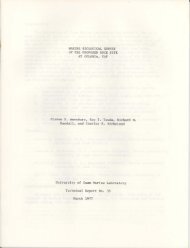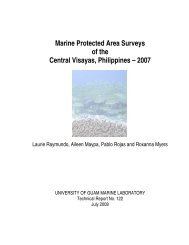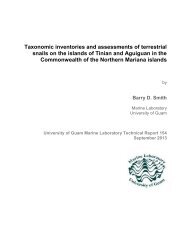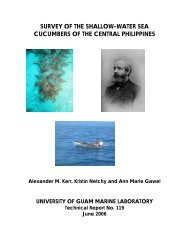POND CULTURE OF SIGANIDS IN T AIW ANIn <strong>the</strong> summer <strong>of</strong> 1991, one <strong>of</strong> us (SGN) visited an aquaculture farm at Penghu, <strong>of</strong>f<strong>the</strong> western coast <strong>of</strong> Taiwan, and interviewed Mr. Hsien-Chung Hsu, a farmer that has hadexperience in <strong>the</strong> commercial production <strong>of</strong> <strong>rabbitfish</strong>. It is hoped that this information - sogenerously provided by <strong>the</strong> grower - might prove useful in estimating <strong>the</strong> potential for siganidaquaculture on Guam.Although siganids are not common in <strong>the</strong> markets <strong>of</strong> Taiwan, <strong>the</strong>y are raisedcommercially at Penghu and also at Keelung in nor<strong>the</strong>rn Taiwan. The species being raised is<strong>Siganus</strong> fuscescens, a species which is known from Micronesia, although it has beenpreviously referred to as <strong>Siganus</strong> canaliculatus in this region. In Penghu, siganids arecurrently raised in pond culture as a secondary species along with sea bream or grouper. Inthis capacity, <strong>the</strong> siganids function to control <strong>the</strong> growth <strong>of</strong> benthic algae in <strong>the</strong> ponds as wellas contributing to overall production. Siganids have also been raised as <strong>the</strong> primary speciesin pond culture, and <strong>the</strong> information reported here refers to <strong>the</strong> production <strong>of</strong> siganids inmonoculture at Penghu, Taiwan.For stocking, fry are collected from <strong>the</strong> wild, because hatchery-produced siganid fryare not available in Taiwan. Fry are purchased from fishermen and are available from Maythrough July. The pond is stocked with 3-cm juveniles at a density <strong>of</strong> 15 fish per squaremeter. The fish are harvested after a 6-month grow-out period, by which time <strong>the</strong> fish havereached an average size <strong>of</strong> approximately 100 grams. Survival in <strong>the</strong> pond is approximately80%. Production is 1.5 kg per square meter in 180 days.In Taiwan, siganids are most popular in <strong>the</strong> markets <strong>of</strong> coastal cities. In Penghu,siganids are sold in <strong>the</strong> fresh, whole state at fish markets and restaurants. Split and sun-driedsiganids are also common in <strong>the</strong> markets <strong>of</strong> Penghu, especially at retail outlets that specializein dried fish products. In general, larger individuals are marketed in <strong>the</strong> dried product form,more than in <strong>the</strong> fresh, whole form. Fresh fish weighing approximately 100 grams aredesirable in <strong>the</strong> markets <strong>of</strong> Taiwan, and this size at harvest has proven to be <strong>the</strong> mostpr<strong>of</strong>itable for commercial aquaculture production. In Penghu, a farmer gets NT$15 for eachfish <strong>of</strong> this size or NT$150 per kilogram (approximately US$5.56/kg) for fresh, whole fish.Siganids sold live bring prices <strong>of</strong> up to NT$300 per kilogram (US$II.I1/kg). The driedsiganids sold for retail prices <strong>of</strong> approximately $NT400 per kilogram (US$14.81/kg).Although many commercially available fish feeds are available in Taiwan, <strong>the</strong> farmerin Penghu prepares his own feed. This consists <strong>of</strong> a mixture <strong>of</strong> 30% soybean powder, 20%rice hulls, 20% com meal, and 30% ground fish. With this feed, feed conversion ratios(kilograms <strong>of</strong> feed per kilogram <strong>of</strong> fish produced) <strong>of</strong> approximately 2.0 were obtained. Thisfeed conversion ratio is similar to that obtained in commercial milkfish culture on Guam(Nelson, 1990).25
The major problems encountered in <strong>the</strong> culture <strong>of</strong> siganids in Penghu were mostlyassociated with temperature. In <strong>the</strong> winter when <strong>the</strong> temperature drops below 13°C <strong>the</strong> fishdie easily; this will not be a problem in culturing siganids on Guam. However, <strong>the</strong> fannerfound that <strong>the</strong> fish are stressed at high temperatures and die easily when pond temperaturesexceed 32°C. According to <strong>the</strong> fanner, larger fish, those weighing over 120 grams, are morelikely to die at high temperatures than smaller fish. At Penghu, optimal temperatures forgrowth fall between 15°C and 30°C.Although, <strong>the</strong>re are few fanns in Taiwan currently producing siganids as a primarycrop, <strong>the</strong> fanners <strong>the</strong>re have found through experience that <strong>rabbitfish</strong> grow well in ponds andthat <strong>the</strong>y have feed conversion ratios similar to those found for o<strong>the</strong>r commercially cultivatedfishes. Presumably, similar rates <strong>of</strong> growth and feed conversion ratios would be obtainedwith <strong>Siganus</strong> <strong>randalli</strong> under similar conditions <strong>of</strong> cultivation.26
















